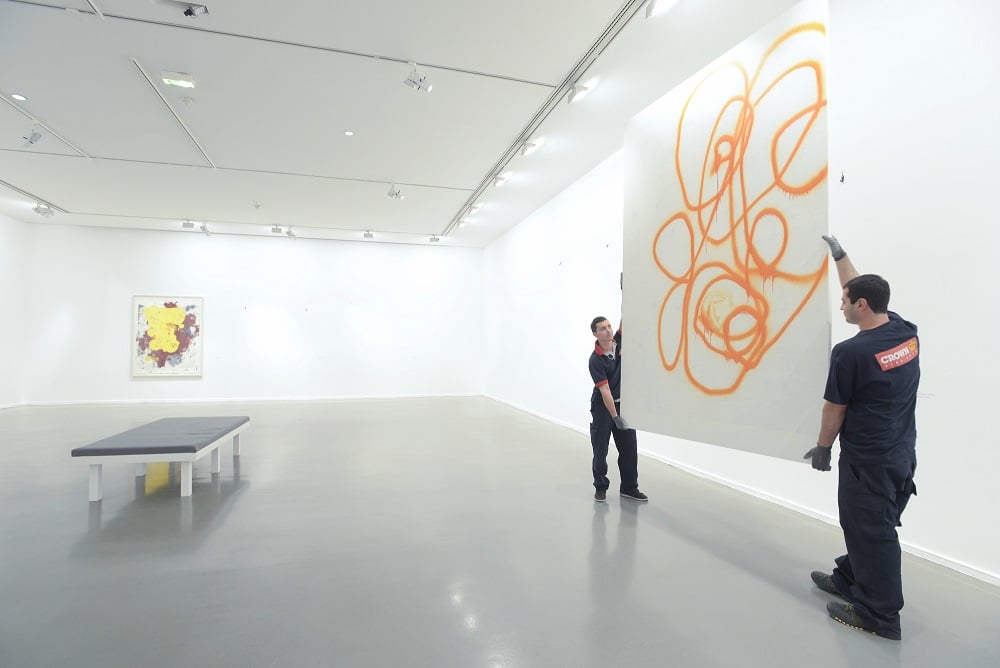
How to… be an art technician
When you look at a painting in a gallery, do you ever wonder how it got there? David Gosling explains how to stay cool and focused whilst moving priceless pieces of art.
Art technicians use huge technical skill to make sure works of art arrive safely at their destination. As a lot of work takes place behind the scenes, many people are unaware that it can be an alternative way to be involved in the art world.
What does being an art technician mean?
Being an art technician involves safely packing, moving, unpacking, installing and de-installing art without damaging the items, people or property.
I work for a fine art logistics company and my job involves securely transporting artworks and objects on behalf of clients including art galleries, museums and private art collectors. This work tends to be for many different types of exhibitions and projects and is usually more varied than the alternative option – working in-house for a gallery or museum.
Art technicians undertake difficult projects that clients are unable to execute themselves without specialist expertise. Their job is to provide the know-how, problem-solving skills and equipment to help ensure often priceless items are moved seamlessly.
What attributes do you need?
The industry is looking for people who are practical, pragmatic and considered. The artwork being moved often has both monetary value and strong emotional significance to the client and the wider public. It’s essential to fill the client with confidence.
Being able to plan effectively is central to a successful project – you can never have too much information. For bigger projects, an initial on-site inspection takes place before anything has been moved and is vital for rigorously assessing potential hazards. It has to be a detailed process because even a table leg that hasn’t been accounted for could end in one of the team tripping and damaging a painting, the table or themselves. Clients expect surroundings to be left exactly as they are found.
You have to appreciate that you may need to deviate from the plan. Factors can change on the day and you need the ability to stay calm, level-headed and flexible. For instance, a carefully planned access route may suddenly be blocked, so an alternative strategy is needed.
The five best projects David has worked on:1. Moving a 38 tonne World War II tank between museums 2. Installing furniture and art at a castle in Kent 3. Moving an entire Mayfair gallery 4. Flying to Munich for the day to deliver a medieval book 5. Wrapping a two-storey tall painting prior to a gallery refurbishment |
The job involves a high level of technical skill. It’s usually said that being an art technician takes two years to learn, and five years to master. It demands detailed knowledge of the items being moved and a deep understanding of how best to pack them to prevent damage in transit. When you arrive to install, expert use of the equipment is essential and it is an art technician’s responsibility to ensure art or objects are installed with the quality sought by the client. This role is central to the way an exhibition looks and feels.
It is important to be prepared for varied working hours because art technicians normally work outside of the nine to five framework. The combination of time pressures from clients and the need to move items while galleries and museums are closed to the public means projects will frequently take place late into the night.
Mental strength is more important than physical. Successful art technicians should never be overawed by prestigious objects but treat all items with the same level of importance. There will be scenarios where you are moving an item at the end of a long shift while the client is watching and it is vital to remain focused and diligent. You are the last line of defence – you have to remember that this is a job that the client couldn’t be doing.
How do I get a foot in the door?
A lot of art technicians are artists themselves and see this career path as an alternative means to being involved in the art world.
You don’t need to have an artist’s background to thrive in this area of work though. I have a different background to some of my colleagues and my enjoyment often comes from the history behind the objects I’m handling.
I studied for a master’s degree in Heritage Management before volunteering in a museum for a year. My previous job was as Head of Storage & Movement for Imperial War Museums and I was lucky enough to move historical objects – such as the very piece of paper Neville Chamberlain held in his “I hold in my hand a piece of paper…” speech! Having contact with these important parts of history is a real privilege. It also makes great dinner party chat and my Dad loves telling his friends about it down the pub.
What’s great about the job?
Working in the art industry allows you to spend time around objects with extraordinary stories and enables you to spend time in the company of fascinating people.
Often the projects you work on are topical and it is not unusual to watch the news and see a project you’ve recently been a part of. The job also gives you a different perspective of the city you live in; I certainly look at London in a different light now.
I love my job and would highly recommend it to anyone looking for an exciting and varied career – but prepare to work hard!
If being an art technician proves appealing, the next step is to experience it yourself. Apprenticeship opportunities are available, including with Crown Fine Art.
David Gosling is Technical Project Manager at Crown Fine Art.
www.crownfineart.com
Join the Discussion
You must be logged in to post a comment.